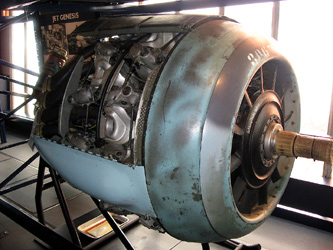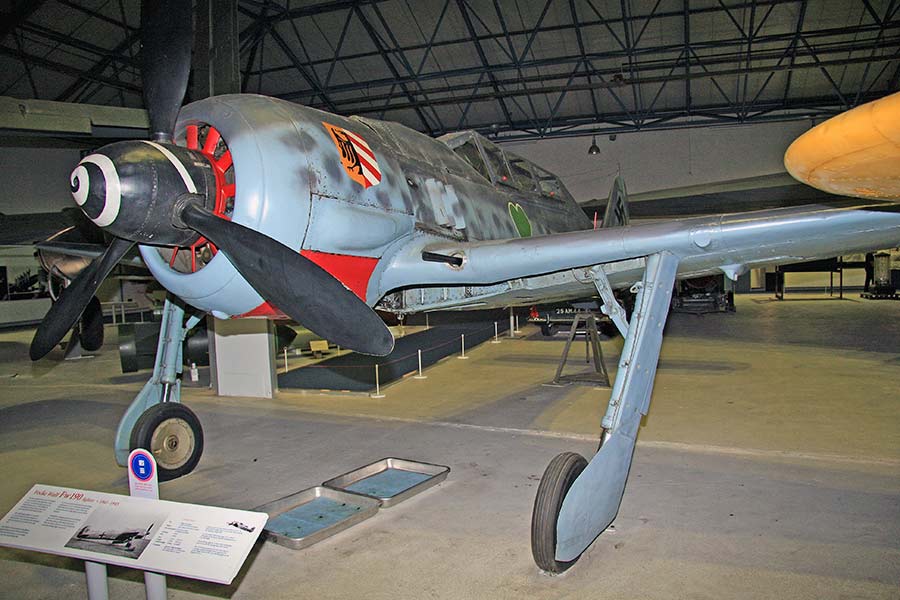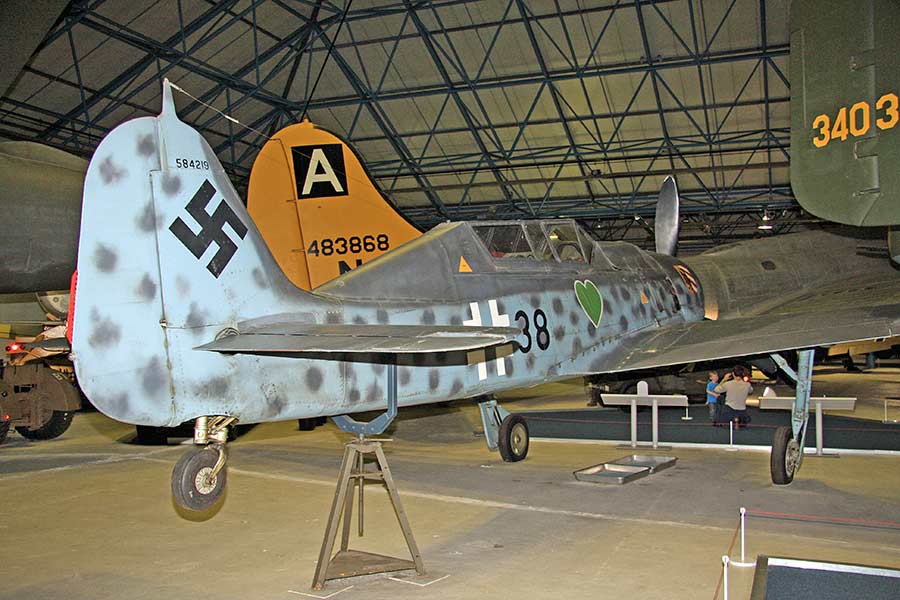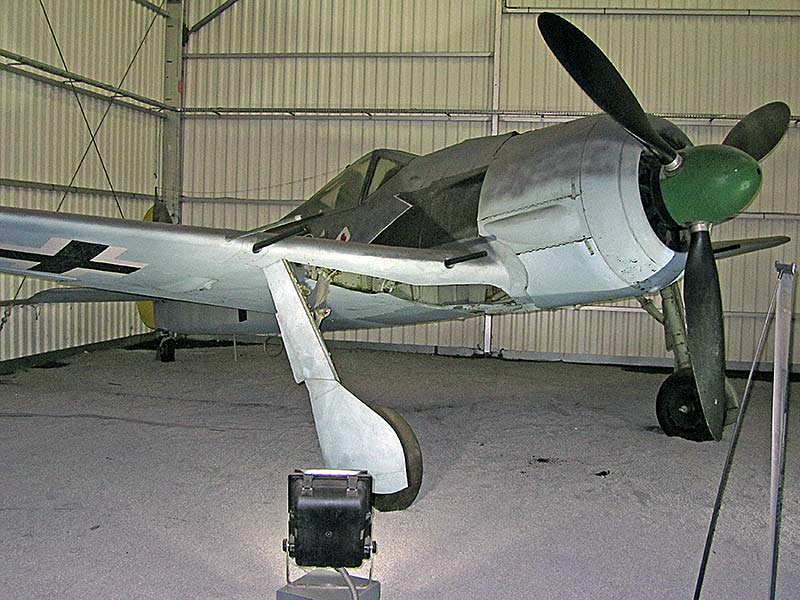



Focke-Wulf Fw 190 A.8 (733682) [@ Imperial War Museum]
 The Focke-Wulf Fw 190 was one of the most successful combat
aircraft of the Second World War and its introduction into service on the
English Channel coast in 1941 marked the beginning of a period of heavy losses
and mounting alarm for the RAF. This new German radial-engined fighter was
superior in almost all respects to the contemporary
Spitfire Mk V and was able to
maintain this advantage until the arrival of the first Spitfire Mk
IX's in July
1942.
The Focke-Wulf Fw 190 was one of the most successful combat
aircraft of the Second World War and its introduction into service on the
English Channel coast in 1941 marked the beginning of a period of heavy losses
and mounting alarm for the RAF. This new German radial-engined fighter was
superior in almost all respects to the contemporary
Spitfire Mk V and was able to
maintain this advantage until the arrival of the first Spitfire Mk
IX's in July
1942.
733682 is the only single-seated version of a Fw190 on display in the UK. It is an example of the most frequently built variant, the A.8, and was captured and evaluated by the RAF before being presented to the museum in the 1960's.
The Focke-Wulf Fw 190 stemmed from a suggestion by the German Air Ministry in 1937 that the company should develop an interceptor fighter to complement the Bf 109. Instead of opting for the Daimler Benz DB601 in-line engine, already in production for the Bf 109, Kurt Tank, Focke-Wulf's technical director, chose the BMW type 139 18-cylinder radial, which was still in the development stage. Three prototypes were built, the first of which flew on 1 June 1939. Apart from some engine overheating problems the flight tests went very well and construction of the other prototypes was accelerated. The fifth Fw 190 was re-engined with the new 1660hp BMW 14-cylinder 801 C0 engine (photograph - right) and this met all the Luftwaffe requirements. Its success led to the construction of 30 pre-production aircraft designated Fw 190 A.0, these being followed by the Fw 190 A.1, which went into service with JG26 at Le Bourget, Paris, in August 1941.
The Fw 190 A.1 was followed into production by the A.2 (426 built), with a longer span and heavier armament and 509 A.3 fighter-bombers. Both JG 2 and JG 26 rearmed with the A3 in June 1942 and began attacks on targets on the south coast of England. The next variant, the Fw 190 A.4, of which 494 were built, had a methanol-water power boost system. The A.5 was a development of the A.4 with the engine relocated 0.15m (5.9in) further forward; 723 aircraft were delivered, and undertook a variety of roles including assault, night fighting, torpedo-bomber and bomber destroyer. Some A5s were modified as two-seat Fw 190 S.5 trainers, the S denoting Schulflugzeug (training aircraft). The Fw 190 A.6, of which 569 were built, was a version of the Fw 190 A.5/U.10 fighter with a lightened wing structure and a fixed armament of four 20mm (0.79in) cannon.


Focke-Wulf Fw 190 A.8/U.1 (584219) [@ RAF Hendon]
The Fw 190 A.7, which entered production in December 1943, had a revised armament of two 20mm (0.79in) cannon in the wing roots and two 12.7mm (0.50in) machine guns in the forward fuselage. Only 80 aircraft were built before it was supplanted by the Fw 190 A.8, the last new-build variant of the Fw 190 A series. Total production was 1334 aircraft. The A.8 was fitted with a nitrous oxide power boost system and an extra fuel tank in the rear fuselage. Some were converted to the training role with the designation Fw 190 S.8.

Focke-Wulf Fw 190 A.8/U.1 (584219) [@ RAF Hendon]
Although the Focke-Wulf company manufactured a prototype two-seat Fw190 to help with the conversion of pilots from slower ground attack units, all the other two-seaters, like 584219, were produced by modifying existing aircraft. 584219 was converted to a two-seat variant by R.Sochor Fabrik at Blanz-Blansko in Poland during late 1944.
Although designed as a fighter, the Fw 190 proved readily adaptable to the ground attack role, and 1942 saw the emergence of the Fw 190 G long-range attack variant. This interim aircraft was followed, out of sequence, by the Fw 190 F, which was basically a Fw 190 A.5 airframe with strengthened landing gear, more armour protection, and a combination of one ETC 501 bomb rack under the fuselage and four ETC 50 bomb racks under the wings. A batch of 30 Fw 190 F.1 aircraft was followed by 271 Fw 190 F.2s with an improved canopy, about 250 Fw 190 F.3s with a revised wing structure, 385 Fw 190 F.7s based on the Fw 190 A.7, and an unknown number of Fw 190 F.9s with the powerful 2270hp BMW 80ITS/TH turbocharged engine.


Focke-Wulf Fw 190 A.8 [@ Musée de l'Air et de l'Espace, Paris - Le Bourget]
The final, and much altered, version of the Fw 190 was the Fw 190 D. In this model, the BMW radial engine that had powered earlier versions was discarded and replaced by the 1776 hp Junkers Jumo 213 A1 engine, a liquid-cooled power- plant whose annular radiator duct gave the new variant a radial-engined appearance.
The major production model was the D.9, which, characterized by its long, newly contoured engine cowling, entered service with III/JG 54 in the autumn of 1944, followed by I/JG 26. Both Gruppen were given the task of defending the air bases used by the Messerschmitt 262 jet fighter. Early in 1945 II/JG 26 also rearmed with the type, as did JG 2, JG 6 and JG 301. The Fw 190 D.9 was a pure interceptor; other variants, equipped for ground attack, included the D11 with two wing-mounted 30mm (1.19in) MK108 cannon, and the D12 and D13, powered by a Jumo 213F engine and armed respectively with a single nose-mounted MK 108 or MK103.
The Focke-Fw 190 A.8 in the above the photograph is displayed in the markings of Josef Priller, a German Ace with 101 victories.